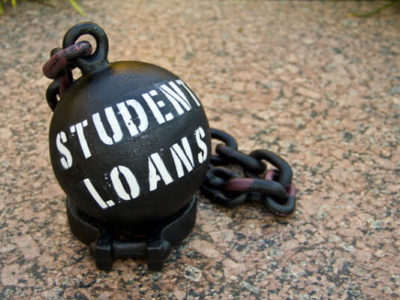After filling out all those forms before the first day of class, most of us choose to forget about our student loans after we sign the dotted line. Debt was just something to deal with later. Well, now it’s later—second semester, senior year. Making post-graduation plans is tough enough without the added stress of those loans looming over your head. As tempting as it can be to pretend they don’t exist and to put off payments just a little longer, it will only make it worse in the long run. Here are seven easy steps to paying back your student loans.
1. Open your browser, do some research

Before you can even start paying back your student loans, you need to know what types you have, how much you owe and who’s getting the paycheck. All of this information is available on the National Student Loan Data System (NSLDS) website. You can log in with your social security number (yeah, you should know that), birthday and FAFSA pin number.
2. distinguish the loan types

Believe it or not, there’s more than one type of federal loan. The big three: Direct Loan, Federal Family Education Loan (FEEL) and Federal Perkins Loan. Even though all of these programs are funded with government money, they have different lenders. For the Direct and FEEL Loans mentioned above, you make payments to the government, but for the Perkins Loan you owe your school. All federal loans are designed to be repaid within 10 years, 120 installments: Hello commitment. The NSLDS website provides a table that will show you your monthly payment requirements with the interest included.
3. sub or unsub?

After figuring out who’s getting the paycheck, figure out how your loan is structured. There are two types: subsidized and unsubsidized. Although all loans accrue interest, the way you pay that interest depends on the type. In subsidized loans, the government pays interest while you’re a student and during grace and deferment periods. Good luck with that unsubsidized loan; all of the interests falls under your responsibility.
4. Make the most of your grace period.

All federal loans have a grace period: time meant to give you a chance to get your finances in order—and get a job—before the monthly payments begin. The Direct Loans and FEEL Loans have a six-month grace period, while the Perkins Loan gives you a little more time to get your life together with nine months and another six-month grace period after any deferments (they happen).
Pro tip: If you have unsubsidized loans, try to pay the interest that accumulated while you were in school during your grace period. If you don’t, the amount of interest accrued will be added to the balance of your loan after the grace period ends. You’re basically paying interest on the interest, and the amount you pay during the life of the loan will be greater than if you paid the interest as it was added. Why not save the heartache and start early?
5. Sign up for automatic payments.

Sometimes things just slip our mind whether we check the mail late or forget to update an address. Yeah, the frat bro now living in your old apartment probably isn’t going to take care of the bill. Unfortunately, lenders don’t let these little accidents slide. A late payment is a late payment, and it’s going to hurt your credit score, making it hard to get a credit card, buy property or even land your dream job (even employers check your credit). A great way to make sure you never forget is to sign up for automated payments. The bank will automatically make monthly payments from your checking or savings account, and will reduce your interest rate by a quarter of a percent. Just make sure not to blow your checking account on beer the night before the bill is due.
6. Speak to your lender.

You might not get the job that pays $100K from the start, or maybe you didn’t get a job at all because you’re going to graduate school, and now, making those minimum payments is feeling pretty impossible. But if you think you’re going to miss one, don’t just ignore it. Call your lender because there are a lot of options. You can base your minimum payment amount on your annual income or defer for a while (if you qualify). Under certain conditions, you can even get your loans forgiven—no joke, your responsibility to pay is gone forever. Your lender can help you make the right choice and avoid penalties, but you just have to make the call.
Pro tip: Do you want to be a lawyer? Nurse? Teacher? Work for a nonprofit? Do it and erase your debt all at the same time. The Perkins Loan is notorious for its loan forgiveness opportunities. Check them all out on the Federal Student Aid website.
7. Build your credit.

If you’re one of the lucky ones and you’re able to pay back your student loans in a lump sum after graduation, think before you write the check. Surprisingly, a little debt can be a good thing. Showing that you can keep up with payments is a great way to establish good credit. Consider making six to nine payments before killing that loan once and for all.



















